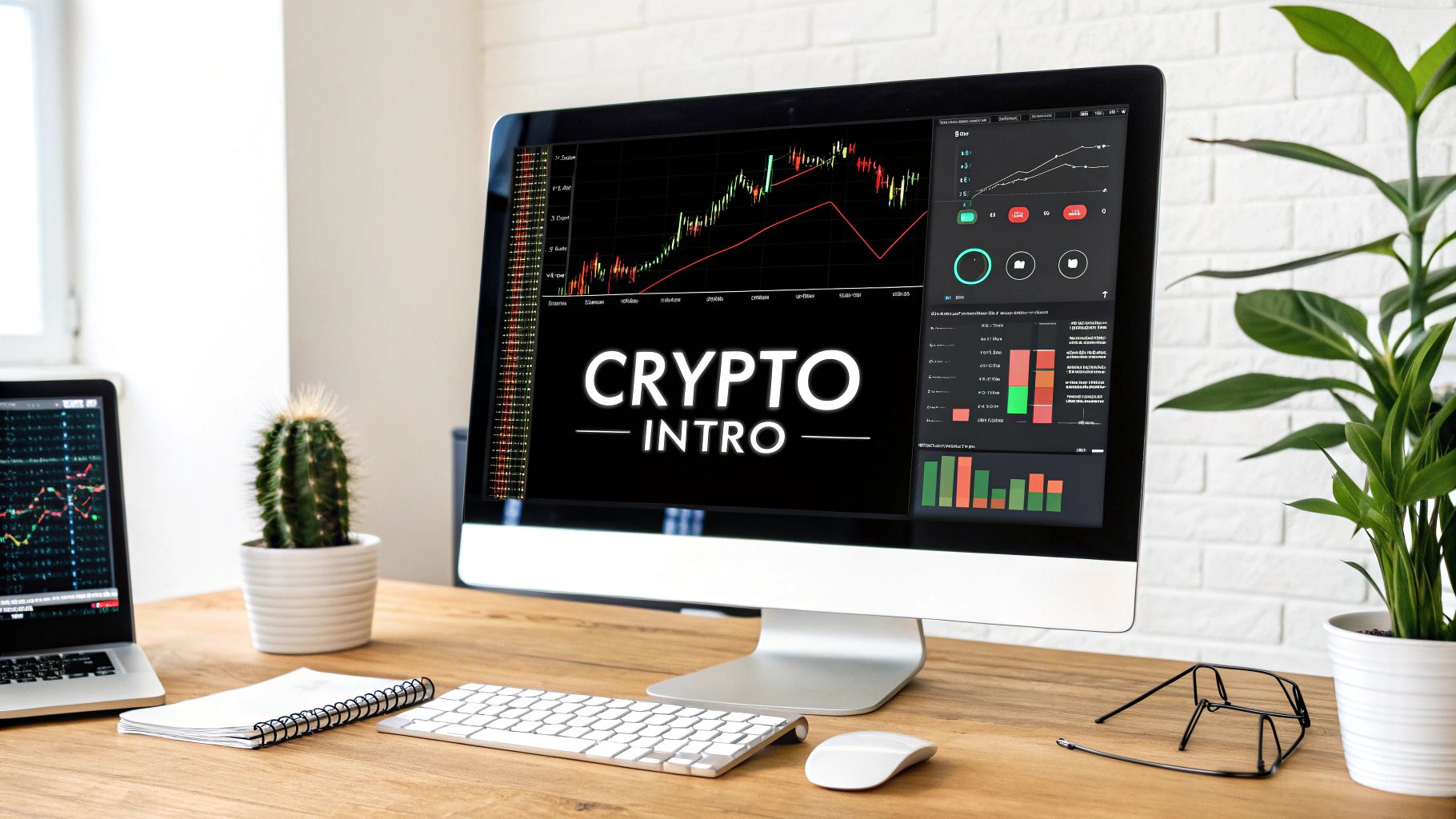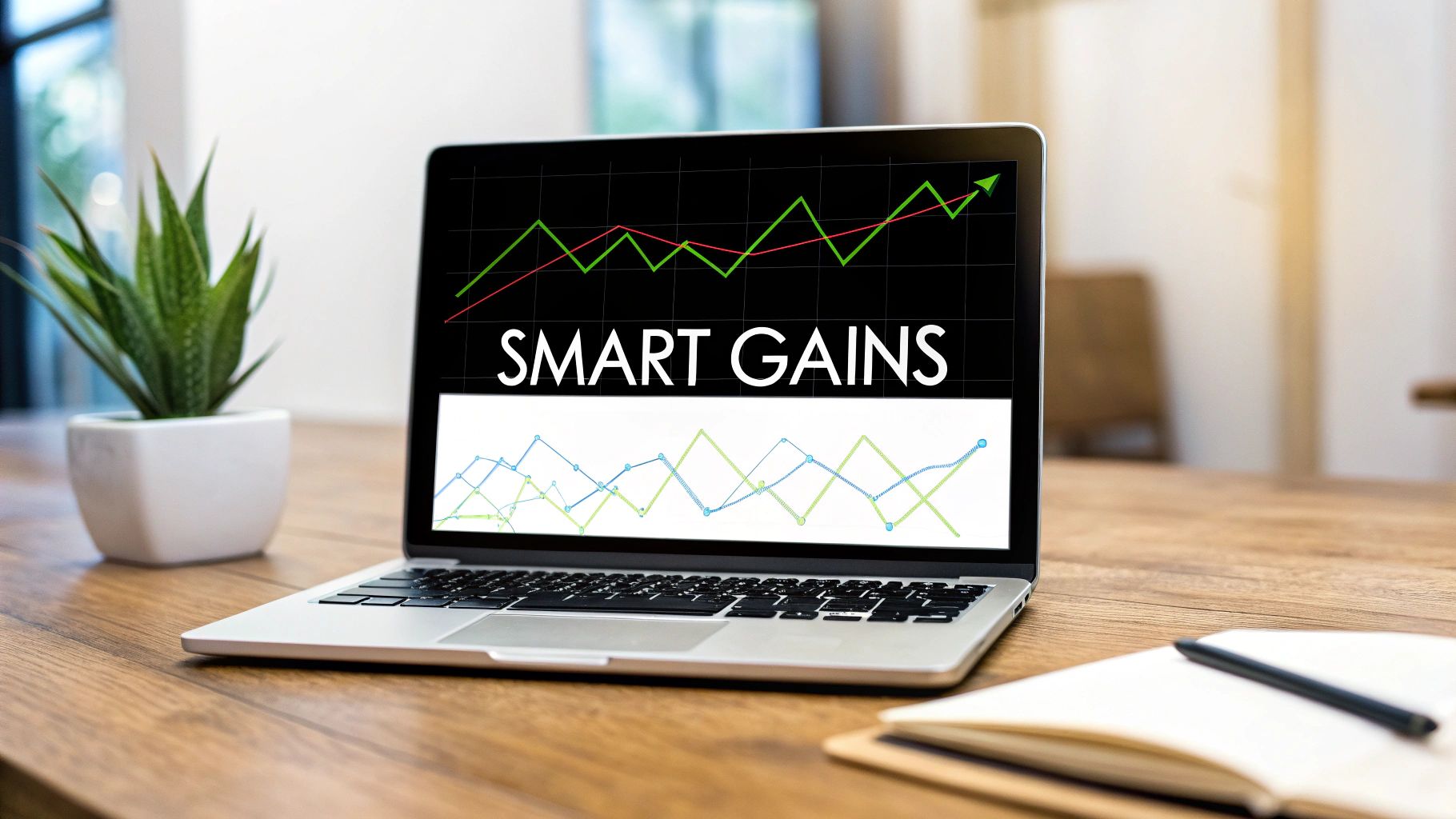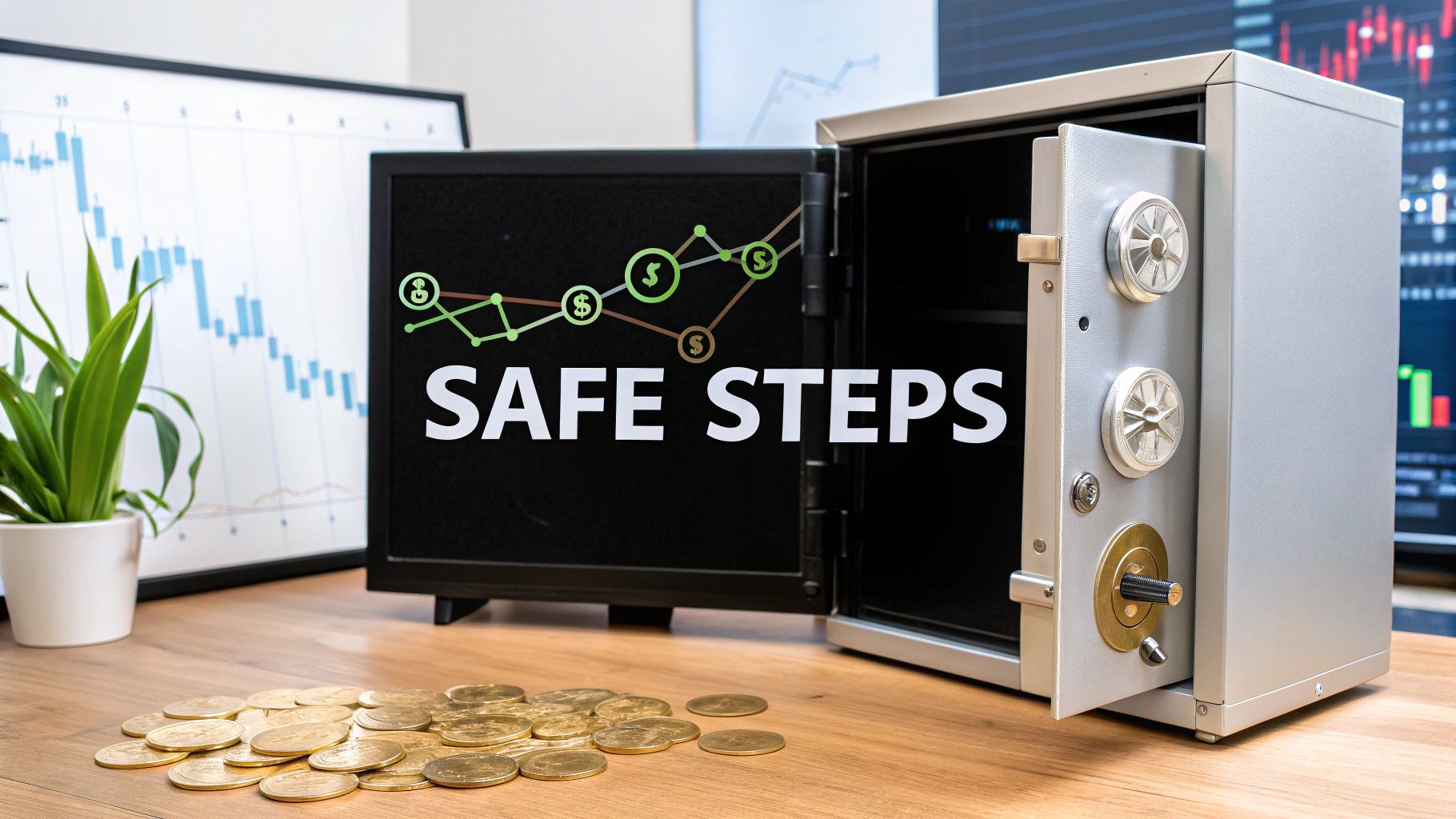Blog
24/7 crypto market, adapting automated systems to crypto regulations, advanced trading tools, advantages of crypto trading bots, AI in crypto, AI-powered crypto investing strategies, AI-powered investing, algorithmic trading, automated crypto investing, automated crypto portfolio, automated investing benefits, automated investment systems, automated strategies for DeFi and NFTs, automated trading, automated wealth management, automation in finance, automation trends in decentralized finance, best automated crypto investing platforms, best crypto investing platforms, best strategies for automated cryptocurrency trading, blockchain investing, choosing the right crypto automation tool, cold storage, compare automated crypto investment platforms, crypto asset management, crypto automation, crypto automation strategies, crypto bots 2025, crypto halving 2025, crypto investing risks, crypto investing security, crypto investing tools, crypto investing tools for beginners, crypto investing trends 2025, crypto investment platforms, crypto investment strategy, crypto investor profile, crypto investor tips, crypto market analysis with algorithmic tools, crypto market trends, crypto platform fees, crypto portfolio automation for 2025, crypto portfolio management, crypto strategies, crypto trading bots, crypto trading execution, crypto wealth management using automation, cryptocurrency ETFs, cryptocurrency investment, cryptocurrency platforms comparison, decentralized finance, DeFi investing, digital asset trading, emotional decision-making in crypto, emotional investing, how to automate cryptocurrency investments, how to avoid hidden fees in crypto trading, how to manage risk in automated crypto investing, institutional crypto investors, institutional impact on crypto investing platforms, integrating automation in crypto asset management, long-term crypto investment automation guide, metaverse investments, NFT investing, optimizing trading bots for market volatility, passive crypto income, regulatory crypto trends, Risk Management, robo-advisors, secure automated crypto trading platforms, spot ETFs, top crypto investing platforms with low fees, top features in crypto investing apps, trading automation benefits
hiddenedge
0 Comments
Automated Crypto Investing: 24/7 Portfolio Growth
Why Automated Crypto Investing Is Changing the Game
The cryptocurrency market’s 24/7 operation presents a significant challenge for investors. Constant monitoring and quick reactions to market fluctuations can lead to burnout. Automated crypto investing offers a solution, bridging the gap between this always-on market and the human need for rest. Automated systems enable continuous portfolio management without constant human oversight, allowing investors to capitalize on opportunities regardless of time or availability.
This hands-off approach has a number of significant benefits for crypto investors. By automating key processes, you can free up time, reduce stress, and potentially improve your investment returns. Let’s take a closer look at some of the key advantages.
Eliminating Emotional Decision-Making
One of the biggest advantages of automation is removing emotional decision-making. Fear and greed often drive impulsive trades, resulting in costly mistakes. Automated systems operate on predefined strategies. They execute trades based on logic and data, not emotions. For example, during a sudden market dip, an automated system won’t panic sell if the strategy dictates holding the asset. This consistent, unemotional approach can lead to more disciplined and potentially more profitable investment outcomes. This data-driven approach ensures your investment decisions remain rational and aligned with your long-term goals.
The Power of Automated Systems
What drives the value of automated systems? Algorithms, execution mechanics, and risk management are the key elements. Algorithms analyze market trends and identify opportunities. Execution mechanics ensure trades are placed swiftly and accurately. Robust risk management protocols protect investments during periods of market volatility. Successful crypto investors are using these technological advantages, combined with carefully planned strategies, to pursue more predictable results. Check out our guide on How to master automated crypto investing. These tools offer an advantage in the fast-paced world of cryptocurrency trading.
Accessibility and Growth of Automated Investing
Automated crypto investing is gaining traction due to its 24/7 operation and ability to analyze data and execute trades according to set strategies. This accessibility, combined with advancements in technology, has the potential to make investing more efficient and profitable. As of 2023, 52% of crypto owners acquired their assets through trading platforms, highlighting the dominance of these platforms. However, automated tools like trading bots and robo-advisors are rapidly gaining popularity for their efficiency in minimizing emotional trading, reflecting a broader trend toward automation in finance. While automation offers numerous benefits, it’s crucial to acknowledge potential risks like technical malfunctions and sudden market shifts. Understanding these risks is the first step towards effective mitigation. Find more detailed statistics here: Crypto Asset Survey 2023

Choosing the Right Automated Crypto Investing Platform

Finding the perfect automated crypto investing platform can feel overwhelming. Not all platforms are equal, and choosing wisely is key to your automated investing success. This means carefully considering several factors to find the best fit for your investment goals and risk tolerance. Let’s cut through the noise and focus on what truly matters when choosing an automation partner.
Key Features to Consider
Effective automated crypto investing platforms share certain key characteristics. It’s essential to understand these features to make an informed decision. Consider the investment strategies offered, the level of automation, and the platform’s security measures. Fees, user experience, and customer support are also crucial.
- Investment Strategies: Does the platform offer the strategies you prefer, such as dollar-cost averaging, algorithmic trading, or arbitrage?
- Automation Level: Will the platform completely automate your investments, or is manual intervention required?
- Security: Look for platforms with robust security like two-factor authentication and cold storage. What measures are in place to protect your assets?
- Fees: Understand all fees: trading, withdrawal, and platform. Hidden fees can impact your returns.
- User Experience: A user-friendly interface simplifies automated investing. How easy is the platform to navigate?
- Customer Support: Reliable customer support is vital when issues arise. What kind of support does the platform provide?
Evaluating Platform Performance
Features are important, but real-world performance and user experiences offer invaluable insights. Research platforms known for specific strengths, like those excelling at dollar-cost averaging versus platforms known for sophisticated algorithmic trading. Knowing which platforms truly deliver on their promises is key.
The rise of AI is also impacting wealth management. For a deeper dive into this trend, check out resources like AI in Wealth Management.
To help you compare and contrast leading platforms, we’ve compiled the following table:
Top Automated Crypto Investing Platforms Comparison
Detailed comparison of leading automated crypto investing platforms, highlighting key features, fees, minimum investments, and user experience ratings.
| Platform | Key Features | Fee Structure | Min. Investment | Supported Coins | User Rating |
|---|---|---|---|---|---|
| Platform A | DCA, Algorithmic Trading | 0.5% per trade | $100 | BTC, ETH, ADA | 4.5/5 |
| Platform B | DCA, Portfolio Rebalancing | 1% annual fee | $500 | BTC, ETH, SOL | 4/5 |
| Platform C | Arbitrage, Margin Trading | 0.25% per trade | $1000 | BTC, ETH, LINK | 3.5/5 |
This table is for illustrative purposes only. Actual platform features, fees, and ratings may vary.
This comparison highlights the importance of researching various platforms. Each platform offers a unique combination of features, fees, and supported coins.
Hidden Fees and Security Considerations
Don’t let hidden fees eat into your profits. Thoroughly investigate each platform’s fee structure. Equally important: robust security to protect your assets. Look for features like cold storage, two-factor authentication, and encryption to safeguard your investments.
Integration and Investor Profiles
Seamless integration with your existing crypto setup can streamline your entire experience. Consider how well each platform integrates with your current tools and exchanges. Also, remember that different platforms cater to different investor profiles. Some platforms are better suited for beginners, while others target experienced traders. Understanding your own investment goals and risk tolerance is key.
Combining Tools for Robust Systems
Many investors combine various tools to create robust automated systems. This approach can diversify investments and potentially boost returns. By leveraging the strengths of different platforms, you can build a comprehensive strategy tailored to your needs. However, carefully manage the complexity of multiple platforms to ensure they work together seamlessly.
Market Forces Reshaping Automated Crypto Investing

The crypto market is constantly changing. This creates opportunities and risks for automated crypto investing. Staying ahead of the curve is essential for success. Let’s explore how major market forces, like institutional adoption and regulatory changes, are influencing automated investing strategies.
Institutional Adoption and Performance Expectations
Institutional investors are increasingly entering the crypto market. They bring sophisticated tools and high performance expectations. This influx of institutional capital impacts market dynamics and raises the bar for automated investing platforms.
Institutions demand robust security, advanced analytics, and fast execution. Platforms serving both institutional and individual investors must adapt to meet these higher expectations. This includes improving security protocols, integrating advanced analytical tools, and optimizing trading speeds.
Regulatory Shifts and Automation Strategies
The regulatory environment around cryptocurrency is evolving. Governments worldwide are determining how to classify and regulate digital assets. These regulatory shifts directly impact automated investing.
Automated systems need flexibility to comply with evolving rules. Regulatory clarity, or the lack thereof, influences which sectors offer the best automated investing opportunities. This necessitates agile systems that can adapt to new regulations as they emerge.
Emerging Sectors and Automated Approaches
While Bitcoin and Ethereum remain central, emerging crypto sectors are attracting attention. Decentralized finance (DeFi), non-fungible tokens (NFTs), and the metaverse present unique opportunities for automated investing.
Platforms are building algorithms and strategies to capitalize on these sectors. This expands the crypto ecosystem and drives innovation in automated investing tools. It also creates new challenges in terms of risk assessment and portfolio management.
The growth of automated crypto investing is linked to broader market trends. By July 2023, the global crypto market cap reached $1.22 trillion. This attracted more retail and institutional investors, leading to renewed venture capital investment in crypto companies. Investors put $1.9 billion into crypto-related companies in late 2023. The approval of spot ETFs and anticipated halving events further boosted interest. For more data, check out these Cryptocurrency Statistics.
Adapting to Market Trends and Mitigating Risks
Automated systems aren’t “set it and forget it.” Successful investors actively monitor market trends and adapt their strategies. This involves adjusting parameters, improving algorithms, and implementing robust risk management.
For example, during volatile periods, investors might adjust stop-loss orders or reduce exposure to certain assets. This active management helps protect capital during downturns and allows for capitalizing on new opportunities. Combining automation with strategic oversight helps investors navigate the dynamic crypto landscape and aim for consistent results.
Crafting Your Winning Automated Strategy

Choosing the right automated crypto investing platform is just the beginning. The real advantage of automation comes from building a well-defined strategy. This involves aligning your automated approach with your investment goals and how much risk you’re willing to take. Let’s explore how successful investors design their automated strategies.
Defining Clear Investment Parameters
A winning automated strategy starts with clear parameters. What are your financial objectives? How much risk can you comfortably handle? Which assets interest you? Answering these questions is crucial for laying the foundation of your automated approach.
For example, are you aiming for steady, long-term growth or quicker, short-term gains? Your answers will determine which assets you target and the strategies you employ.
Position Sizing and Rule Creation
Position sizing, the amount of capital you allocate to each investment, is crucial. Over-investing in a single asset can expose you to unnecessary risk. Diversification and careful allocation are key.
Also, establish clear rules for your automated system. These could include entry and exit points, stop-loss orders, and take-profit targets. Based on your defined parameters, these rules guide your system and keep emotions out of your trading decisions. You might find this helpful: How to master automated crypto rules.
Backtesting and Optimization
After creating your rules, backtesting is essential. Backtesting simulates your strategy’s performance using historical market data. This helps you identify potential weaknesses and refine your approach before live trading.
However, avoid over-optimizing for past performance. Markets are constantly changing, and a strategy that worked well historically may not always be effective in the future.
Let’s take a look at some common automated strategies in the table below. It summarizes different approaches with their risk profiles, potential returns, and ideal investor types.
Automated Crypto Investment Strategies
| Strategy Type | Risk Level | Potential Return | Time Commitment | Best For | Market Conditions |
|---|---|---|---|---|---|
| Dollar-Cost Averaging (DCA) | Low | Moderate | Low | Beginners, Long-term investors | All |
| Grid Trading | Medium | Moderate | Low | Active traders | Ranging |
| Arbitrage | Low | Low | Medium | Experienced traders | Volatile |
| Trend Following | Medium | High | Medium | Active traders | Trending |
| Portfolio Rebalancing | Low | Moderate | Low | Long-term investors | All |
This table highlights how different automated strategies can cater to various risk tolerances and market conditions. DCA, for example, is ideal for beginners due to its simplicity and lower risk, while trend following requires more experience and active monitoring.
Adapting and Evolving Your Strategy
The crypto market is dynamic, so your automated strategy should be too. Continuously monitor your system’s performance and be ready to adjust. This might involve tweaking existing rules, adding new ones, or even completely changing your overall approach.
For example, if market conditions shift dramatically, you might need to re-evaluate your risk tolerance and adjust your position sizing. This ongoing adaptation is key to staying ahead of market trends and maximizing your potential.
Realistic Return Expectations and Market Cycles
While automated investing offers potential benefits, it’s crucial to have realistic return expectations. No system guarantees profits, and the crypto market is inherently volatile. Be prepared for market cycles and avoid making impulsive changes to your strategy based on short-term price fluctuations.
This requires a long-term perspective and maintaining discipline through both bull and bear markets.
Maintaining Consistency Through Market Cycles
A major advantage of automated crypto investing is the consistency it offers, regardless of market conditions. Your system continues to operate based on your predefined strategy even during periods of high volatility. This helps avoid emotional reactions and ensures your investment plan stays on track.
By sticking to your plan and avoiding constant intervention, you’re more likely to achieve long-term success in the dynamic world of automated crypto investing. This consistent approach, coupled with regular monitoring and adaptation, forms the foundation of a winning automated strategy.
How Automation Is Transforming Crypto Markets
Automated crypto investing is reshaping the dynamics of cryptocurrency markets, creating both exciting prospects and potential pitfalls. These changes affect crucial areas like market liquidity, price discovery, and overall market efficiency.
Algorithmic Trading’s Impact
Algorithmic trading, a key element of automated crypto investing, executes trades according to pre-programmed instructions. This automation can boost market liquidity by enabling more frequent trades. However, this frequency can also lead to rapid price fluctuations if algorithms react similarly to market events, raising concerns about market stability and predictability. A crucial step after defining your strategy is learning how to automate your trading strategy and its execution.
For instance, if numerous algorithms are designed to sell during a market downturn, the combined selling pressure could intensify the decline. Conversely, synchronized buying could artificially inflate prices. This underscores the importance of careful algorithm design and robust risk management.
Market Manipulation and Systemic Risks
Automated systems, despite their efficiency, can also introduce new systemic vulnerabilities. While these systems may reduce certain types of market manipulation by eliminating emotional human actions, they can be exploited if vulnerabilities in their programming are discovered. The potential impact of automated crypto investing on market dynamics is significant, particularly regarding market efficiency and risk management.
Trading bots, for example, can execute trades faster than humans, responding to market signals in real-time. This speed can lead to improved trading outcomes by minimizing emotional decision-making and impulsive trades during market volatility. Automated platforms also offer extensive analytics to help users evaluate their portfolio performance. While the market for AI-related crypto assets is growing, with AI tokens exceeding a combined market value of $39 billion in early 2024, automated investing tools must adapt to incorporate evolving trends and technologies. Explore more about automated investing strategies.
Evolution and Competition
The automated crypto investing landscape is constantly evolving. Various automated approaches compete, driving innovation and shaping new market patterns. This competition leads to more sophisticated algorithms, improved risk management tools, and greater efficiency for investors.
This continuous evolution provides opportunities for astute investors to capitalize on emerging patterns. By understanding the interplay of automated systems and their influence on market behavior, investors can refine their strategies for potentially better outcomes. Staying informed about the latest developments and adapting to the changing dynamics of automated crypto markets is crucial.
Adapting to the Automated Landscape
Investors must acknowledge the dynamic nature of these markets. Developing a successful automated investing strategy requires not only selecting the right platform but also carefully planning for changing market conditions. Adaptability and continuous learning are essential for success in this rapidly evolving environment. This includes ongoing monitoring, strategic adjustments, and a disciplined, long-term perspective.
Protecting Your Capital Through Automation
Automated crypto investing presents exciting opportunities, but it also carries inherent risks. Even the most sophisticated automated systems have vulnerabilities that can significantly impact your portfolio. Let’s explore these common risks and discuss practical strategies to mitigate them.
Understanding the Risks of Automated Crypto Investing
Automated systems are designed for efficient trade execution. However, they can be susceptible to unforeseen market events. A sudden market crash, for example, could result in substantial losses if the system isn’t designed to react appropriately. This underscores the importance of robust risk management tailored to automated investing.
Technical glitches within the automated platform itself can also disrupt trading. These issues can range from software bugs to connectivity problems, leading to missed opportunities or unintended trades. Understanding the platform’s reliability and its safeguards is crucial.
Implementing Effective Risk Management Strategies
Several key strategies can help safeguard your capital in automated crypto investing. One essential tool is the stop-loss order. A stop-loss order automatically sells an asset when its price drops to a predetermined level, limiting potential losses. It acts as a safety net, protecting your investments from steep declines.
Position sizing is another critical element. This involves determining the appropriate amount of capital to allocate to each investment. Diversification, avoiding overexposure to any single asset, is key to effective risk management. Spreading investments across various assets helps mitigate losses if one asset underperforms. For more information, see: How to master automated crypto investing FAQs.
Circuit breakers provide another layer of protection. These temporarily halt trading during periods of extreme market volatility, offering a buffer against rapid price swings. This pause allows the market to stabilize, preventing cascading losses triggered by automated systems reacting to volatile price movements.
The Importance of Human Oversight
While automation removes emotion from trading, human oversight remains essential. Regularly monitoring your automated system’s performance allows you to identify potential issues, adjust strategies as needed, and intervene when necessary. Automated systems don’t eliminate the need for active involvement.
Successful investors strike a balance between automation and strategic intervention. They use automated systems for efficient execution but remain actively involved in overseeing their portfolios. This combination of technology and human intelligence is crucial for long-term success in automated crypto investing.
Real-World Examples and Risk Mitigation Techniques
Real-world scenarios highlight the importance of effective risk management. During market corrections, investors using robust stop-loss strategies and diversified portfolios often perform better than those with less sophisticated risk management.
For example, during the 2018 crypto market crash, investors who implemented stop-loss orders limited their losses and preserved capital, allowing them to reinvest when the market recovered. These examples demonstrate the practical value of risk mitigation techniques and their ability to protect investments during periods of market turbulence.
By understanding the risks of automated crypto investing and implementing appropriate safeguards, you can confidently pursue your investment goals while protecting your capital.
The Future of Automated Crypto Investing
The world of automated crypto investing is constantly evolving. New technologies and shifting market dynamics are creating exciting opportunities. Savvy investors are closely watching these trends to position themselves for future success. Let’s explore some key advancements shaping this exciting space.
Artificial Intelligence and Machine Learning
Artificial intelligence (AI) and machine learning (ML) are transforming automated trading. These technologies empower algorithms to adapt to changing market conditions, identifying intricate patterns that human traders often miss.
AI-powered systems can analyze massive datasets. This includes historical market data, news sentiment, and on-chain activity. This analysis can predict future price movements and create more nuanced trading strategies.
On-Chain Data Analysis for Deeper Insights
On-chain data analysis gives automated systems a deeper understanding of what’s happening in the market. By analyzing transaction data directly from the blockchain, algorithms can gain insights into investor behavior, large investor activity (“whale activity”), and overall market sentiment.
This transparency offers a significant advantage over traditional market analysis. It provides a more granular perspective on the factors influencing crypto markets.
Decentralized Automation Through Smart Contracts
Smart contracts are self-executing contracts with terms written directly into code. They’re creating new possibilities for automated investing. These contracts can automate investment strategies without intermediaries, potentially reducing fees and improving security.
A smart contract could automatically execute a trade when a certain price is reached. This ensures swift execution and removes the risk of human error or manipulation.
Positioning for Future Advancements
Successful crypto investors are taking steps to benefit from these advancements. This includes adopting platforms that incorporate AI, ML, and on-chain data analysis, and exploring decentralized automation opportunities. This forward-thinking mindset keeps them ahead of the curve.
Maintaining flexibility is equally important. The crypto market is constantly changing. Adapting quickly is essential for long-term success. Continuously evaluating new technologies and refining strategies is critical.
Ready to experience the future of automated crypto investing? Explore the solutions offered by Hidden Edge and discover how we can help you reach your investment goals.









Post Comment